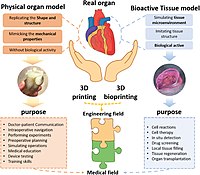
Photo from wikipedia
Cardiovascular diseases are considered one of the worldwide causes of death, with atherosclerosis being the most predominant. Nowadays, the gold standard treatment is blood vessel replacement by bypass surgery; however,… Click to show full abstract
Cardiovascular diseases are considered one of the worldwide causes of death, with atherosclerosis being the most predominant. Nowadays, the gold standard treatment is blood vessel replacement by bypass surgery; however, autologous source is not always possible. Thereby, tissue-engineered blood vessels (TEBVs) are emerging as a potential alternative source. In terms of composition, collagen has been selected in many occasions to develop TEBVs as it is one of the main extracellular matrix components of arteries. However, it requires specific support or additional processing to maintain the tubular structure and appropriate mechanical properties. Here, we present a method to develop support-free collagen TEBVs with co-axial extrusion in a one-step procedure with high concentrated collagen. The highest concentration of collagen of 20 mg/mL presented a burst pressure of 619.55 ± 48.77 mmHg, being able to withstand perfusion of 10 dynes/cm2. Viability results showed a high percentage of viability (86.1 and 85.8% with 10 and 20 mg/mL, respectively) of human aortic smooth muscle cells (HASMCs) and human umbilical vein endothelial cells (HUVEC) after 24 h extrusion. Additionally, HUVEC and HASMCs were mainly localized in their respective layers, mimicking the native distribution. All in all, this approach allows the direct extrusion of collagen TEBVs in a one-step procedure with enough mechanical properties to be perfused.
Journal Title: International Journal of Molecular Sciences
Year Published: 2022
Link to full text (if available)
Share on Social Media: Sign Up to like & get
recommendations!